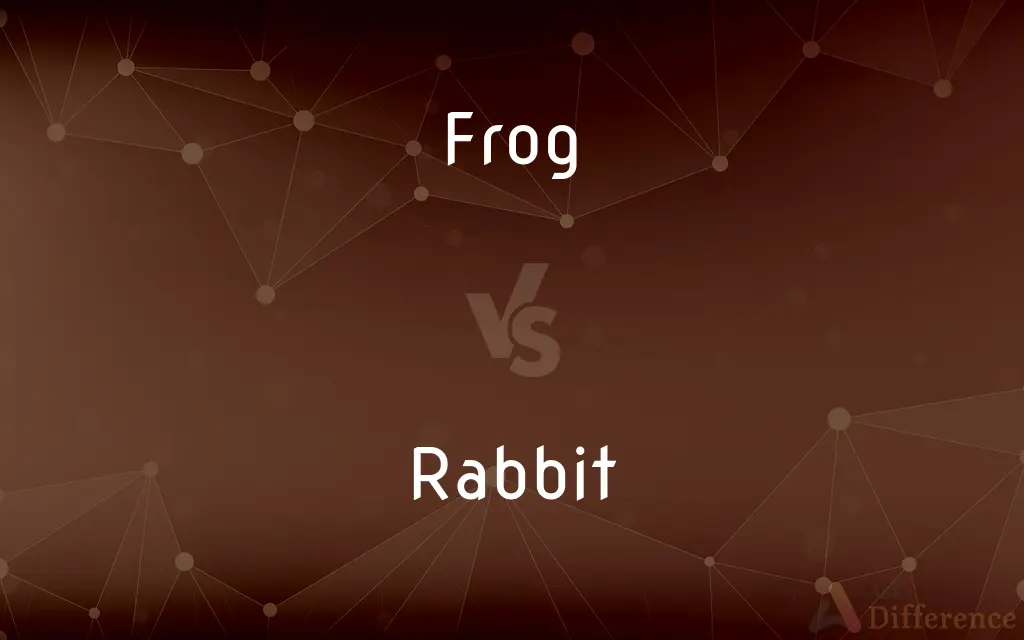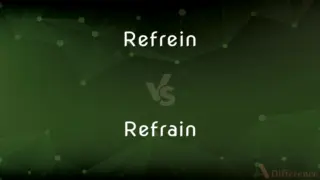Frog vs. Rabbit — What's the Difference?
By Maham Liaqat & Fiza Rafique — Updated on April 2, 2024
Frogs are amphibians known for their jumping abilities and aquatic life stages, while rabbits are mammals distinguished by their long ears and burrowing habits.

Difference Between Frog and Rabbit
Table of Contents
ADVERTISEMENT
Key Differences
Frogs belong to the amphibian class, requiring moist environments to survive due to their permeable skin, which aids in respiration and moisture absorption. Conversely, rabbits are mammals, characterized by their fur-covered bodies, which help regulate body temperature and offer protection from environmental elements.
Frogs are known for their exceptional jumping abilities, facilitated by their powerful hind legs and elongated ankle bones. Rabbits also possess strong hind legs, but they use them for running and burrowing rather than jumping in the same manner as frogs.
Dietary habits further distinguish these two animals. Frogs are primarily carnivorous, consuming insects, worms, and even small fish, relying on their quick tongues to catch prey. On the other hand, rabbits are herbivores, feeding on a variety of plants, including grasses, leaves, and vegetables.
Frogs have a wide range of habitats, from tropical rainforests to arid deserts, adapting to various environments as long as they can maintain their skin's moisture. Rabbits, particularly wild species, are found in diverse habitats as well but prefer environments that offer ample cover like forests, meadows, and grasslands where they can hide from predators.
Comparison Chart
Class
Amphibian
Mammal
ADVERTISEMENT
Reproduction
Lay eggs, undergo metamorphosis
Give birth to live young
Key Characteristics
Moist, permeable skin; excellent jumpers
Fur-covered body; long ears, strong hind legs
Diet
Carnivorous (insects, small fish)
Herbivorous (grasses, leaves)
Habitat
Moist environments, worldwide
Forests, meadows, worldwide
Compare with Definitions
Frog
Moist Skin.
A frog’s skin must remain wet for oxygen absorption.
Rabbit
Strong Legs for Running.
A rabbit can use its powerful legs to escape predators quickly.
Frog
Amphibious Nature.
Frogs need water to breed and survive.
Rabbit
Burrowing Habits.
Rabbits dig burrows for shelter and to raise their young.
Frog
Jumping Ability.
A frog can leap multiple times its body length to escape predators.
Rabbit
Herbivorous Feeding.
Rabbits have a diet consisting mainly of grass and leafy weeds.
Frog
Carnivorous Diet.
Frogs use their sticky tongues to snatch insects from the air.
Rabbit
Live Birth.
Rabbits give birth to a litter of kits in a burrow.
Frog
A frog is any member of a diverse and largely carnivorous group of short-bodied, tailless amphibians composing the order Anura (literally without tail in Ancient Greek). The oldest fossil "proto-frog" appeared in the early Triassic of Madagascar, but molecular clock dating suggests their origins may extend further back to the Permian, 265 million years ago.
Rabbit
Any of various long-eared, short-tailed, burrowing mammals of the family Leporidae, such as the commonly domesticated species Oryctolagus cuniculus, native to Europe and widely introduced elsewhere, or the cottontail of the Americas.
Frog
Any of numerous tailless aquatic, semiaquatic, or terrestrial amphibians of the order Anura, characteristically having a short vertebral column, a large head, long hind legs used for leaping, and a tadpole stage as larvae.
Rabbit
A hare.
Frog
Any of various usually aquatic members of this order having smoother skin and longer hind legs than the toads.
Rabbit
The flesh of a rabbit, used as food.
Frog
A wedge-shaped, horny prominence in the sole of a horse's hoof.
Rabbit
The fur of a rabbit or hare.
Frog
A loop fastened to a belt to hold a tool or weapon.
Rabbit
A competitor who is designated to set a fast pace for a teammate during a long-distance race.
Frog
An ornamental looped braid or cord with a button or knot for fastening the front of a garment.
Rabbit
A racehorse that is run at a fast pace early in a race in order to tire the favorite so that another horse can take the lead.
Frog
A device on intersecting railroad tracks that permits wheels to cross the junction.
Rabbit
A mechanical decoy that is propelled around the track in a greyhound race to incite the dogs.
Frog
A spiked or perforated device used to support stems in a flower arrangement.
Rabbit
To hunt rabbits or hares.
Frog
The nut of a violin bow.
Rabbit
A mammal of the family Leporidae, with long ears, long hind legs and a short, fluffy tail.
The pioneers survived by eating the small game they could get: rabbits, squirrels and occasionally a raccoon.
Frog
(Informal)Hoarseness or phlegm in the throat.
Rabbit
(uncountable) The meat from this animal.
Frog
Offensive Slang Used as a disparaging term for a person of French birth or descent.
Rabbit
(uncountable) The fur of a rabbit typically used to imitate another animal's fur.
Frog
Any of a class of small tailless amphibians of the order Anura that typically hop.
Rabbit
A runner in a distance race whose goal is mainly to set the pace, either to tire a specific rival so that a teammate can win or to help another break a record; a pacesetter.
Frog
(musical instrument) The part of a violin bow (or that of other similar string instruments such as the viola, cello and contrabass) located at the end held by the player, to which the horsehair is attached.
Rabbit
(cricket) A very poor batsman; selected as a bowler or wicket-keeper.
Frog
(Cockney rhyming slang) Road. Shorter, more common form of frog and toad.
Rabbit
(comptheory) A large element at the beginning of a list of items to be bubble sorted, and thus tending to be quickly swapped into its correct position. Compare turtle.
Frog
The depression in the upper face of a pressed or handmade clay brick.
Rabbit
Rarebit; Welsh rabbit or a similar dish: melted cheese served atop toast.
Frog
(rail transport) The part of a railway switch or turnout where the running-rails cross (from the resemblance to the frog in a horse’s hoof).
Rabbit
A pneumatically-controlled tool used to insert small samples of material inside the core of a nuclear reactor.
Frog
(angling) A type of fishing lure that resembles a frog.
Rabbit
(intransitive) To hunt rabbits.
Frog
Defector: a politician who simply switches between different political parties.
Rabbit
To flee.
The informant seemed skittish, as if he was about to rabbit.
When the three friends heard someone behind them yell, "police, freeze!" they each rabbited in a different direction.
Frog
(offensive) A French person.
Rabbit
To talk incessantly and in a childish manner; to babble annoyingly.
Rabbit on
Stop your infernal rabbiting! Use proper words or nobody will listen to you!
Frog
A French-speaking person from Quebec.
Rabbit
Confound; damn; drat.
Frog
A leather or fabric loop used to attach a sword or bayonet, or its scabbard, to a waist or shoulder belt.
Rabbit
Any of the smaller species of the genus Lepus, especially the common European species (Lepus cuniculus), which is often kept as a pet, and has been introduced into many countries. It is remarkably prolific, and has become a pest in some parts of Australia and New Zealand.
Frog
An ornate fastener for clothing consisting of an oblong button (covered with netted thread), toggle, or knot, that fits through a loop.
Rabbit
Any of various burrowing animals of the family Leporidae having long ears and short tails; some domesticated and raised for pets or food
Frog
To hunt or trap frogs.
Rabbit
The fur of a rabbit
Frog
To use a pronged plater to transfer (cells) to another plate.
Rabbit
Flesh of any of various rabbits or hares (wild or domesticated) eaten as food
Frog
To spatchcock (a chicken).
Rabbit
Hunt rabbits
Frog
To ornament or fasten a coat, etc. with frogs.
Frog
(transitive) To unravel part of (a knitted garment) while knitting it in order to correct a mistake.
Frog
An amphibious animal of the genus Rana and related genera, of many species. Frogs swim rapidly, and take long leaps on land. Many of the species utter loud notes in the springtime.
Frog
The triangular prominence of the hoof, in the middle of the sole of the foot of the horse, and other animals; the fourchette.
Frog
A supporting plate having raised ribs that form continuations of the rails, to guide the wheels where one track branches from another or crosses it.
Frog
An oblong cloak button, covered with netted thread, and fastening into a loop instead of a button hole.
Frog
The loop of the scabbard of a bayonet or sword.
Frog
Any of various tailless stout-bodied amphibians with long hind limbs for leaping; semiaquatic and terrestrial species
Frog
A person of French descent
Frog
A decorative loop of braid or cord
Common Curiosities
Do rabbits hibernate?
Rabbits do not hibernate but remain active throughout the year, adjusting their behaviors to the seasonal availability of food.
How do frogs breathe?
Frogs breathe through their lungs and through their skin, a process known as cutaneous respiration.
Can frogs live both in water and on land?
Yes, frogs are amphibians that can live both in water and on land, especially in moist environments.
What are the predators of rabbits?
Common predators include foxes, birds of prey, and snakes, depending on the rabbits' habitat.
How do rabbits communicate?
Rabbits communicate through a variety of sounds, body postures, and even by thumping their hind legs on the ground.
How do rabbits avoid predators?
Rabbits use their keen senses and quick movements to evade predators, often escaping to burrows for safety.
Can frogs change color?
Some frog species can change color for camouflage or temperature regulation.
What is the lifespan of a frog compared to a rabbit?
Lifespan varies by species, but many frogs can live 5-15 years in the wild, while rabbits typically live around 9-12 years.
What is the impact of frogs on the ecosystem?
Frogs play a crucial role in ecosystems as both predators and prey, helping to control insect populations and serving as food for larger animals.
What kind of habitats do rabbits prefer?
Rabbits prefer environments that provide shelter and food, such as forests, grasslands, and even urban areas.
Do all frogs have the same diet?
While most are carnivorous, the specifics of their diet can vary widely among the different species.
Are rabbits considered pests?
In some areas, especially where introduced, rabbits can be considered pests due to their impact on vegetation and agriculture.
Are frogs social animals?
Frogs can be seen gathering in large numbers during breeding seasons, but they do not form social bonds like mammals.
Can frogs survive in saltwater?
Most frogs need fresh water to survive, though a few species can tolerate brackish water.
Share Your Discovery

Previous Comparison
Cuddle vs. Spoon
Next Comparison
Refrein vs. RefrainAuthor Spotlight
Written by
Maham LiaqatCo-written by
Fiza RafiqueFiza Rafique is a skilled content writer at AskDifference.com, where she meticulously refines and enhances written pieces. Drawing from her vast editorial expertise, Fiza ensures clarity, accuracy, and precision in every article. Passionate about language, she continually seeks to elevate the quality of content for readers worldwide.














































